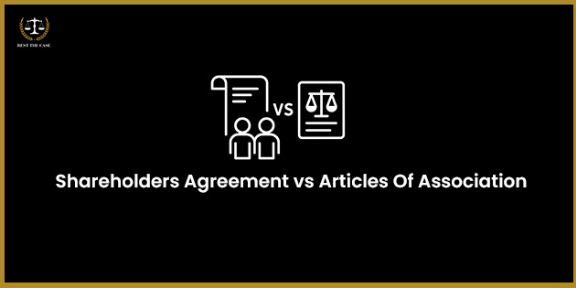Business & Compliance
Shareholders’ Agreement vs. Articles of Association

If you’re running or planning to start a business with partners, two key legal documents will shape how your company operates: the Shareholders’ Agreement and the Articles of Association. While both set the ground rules for your business, they do so in different ways. The Articles of Association form your company’s official, legally required rulebook, outlining governance, voting rights, and share structures. The Shareholders’ Agreement, on the other hand, is a private contract between owners that defines decision-making powers, profit-sharing, dispute resolution, and exit strategies. Understanding the difference between these documents and how they work together can help you avoid confusion, prevent disputes, and ensure smooth, legally compliant operations.
In this article, we’ll explore:
- What is a shareholders’ agreement?
- What articles of association are and why every company must have them
- Main features: decision-making, roles, voting, share transfer, disputes
- Key differences: who they bind, public vs private, legal status, flexibility
- Pros and cons of both documents
- When to use a shareholders’ agreement alongside articles
- Why it’s best to have both documents for business clarity
- FAQs on binding power, privacy, and conflicts
- How these rules protect your company and prevent disputes
What is a Shareholders’ Agreement?
A shareholders’ agreement is a written document made between the owners (shareholders) of a company that sets out clear rules on how the business will be run, how important decisions will be made, and what each owner’s rights, responsibilities, and share of profits will be. Its main aim is to avoid misunderstandings and prevent disputes by agreeing on these matters in advance. It usually covers topics such as how profits will be divided, how new owners can join, what happens if an owner wants to sell their shares or leave, the process for solving disagreements, and protections for smaller shareholders to ensure they are treated fairly. Unlike the Articles of Association, which is a public legal document anyone can view, a shareholders’ agreement is private and only for the company’s owners. It can be tailored to suit the unique needs of the business and updated if all owners agree.
What are Articles of Association?
The articles of association are a bit like the official “rulebook” for your company. To legally register your business, you need to have them; they’re essential. These outline how the company is run, who handles what, how votes work, and what should happen if shares are bought or sold.
Some main things included are:
- How to pick and remove directors, and what they’re allowed to do,
- How meetings are held for both shareholders and directors,
- How voting rights work and how shares are issued or transferred,
- What happens if the company makes a profit and wants to pay dividends,
- Rules about selling or passing on shares.
Unlike a shareholders’ agreement, the articles are public. That means anyone (even outsiders) can see them by looking the company up online.
👉 Read more: Detailed guide on Articles of Association in company law
Key Differences Between Shareholders’ Agreement and Articles of Association
Understanding where these documents overlap (and where they don’t) is very helpful. Here’s a clear comparison:
| Aspect | Shareholders’ Agreement | Articles of Association |
|---|---|---|
Legally required? | No, but highly recommended | Yes, every company must have it |
Who must follow it? | Only those who sign it | All shareholders & directors |
Public or Private? | Private (not seen by the public) | Public (filed for all to see) |
How flexible? | Very flexible, easy to amend | Less flexible, formal changes |
What does it cover? | Custom business relationships, profit sharing, dispute steps, exits, and more | Basic company rules, governance, and share structure |
Minority protection? | Strong protections possible | Limited by law and company rules |
Precedence on conflict | Generally prevails between parties (contract law applies), but cannot override mandatory company law or AOA | Prevails in corporate law matters, binding on all members and filed with registrar |
Binds future shareholders automatically? | No, unless they expressly agree to/sign it | Yes, automatically binds all present and future shareholders |
Filing requirement & discoverability | Not filed with any authority; private contract, confidential | Must be filed with Registrar of Companies (RoC); publicly accessible |
Amendment threshold | Can be amended by unanimous or agreed percentage of signatories (very flexible) | Requires special resolution (typically 75% shareholder approval) and RoC filing |
Enforcement forum (courts/arbitration) | Can provide for arbitration or courts (depends on clause in agreement) | Enforced through courts/tribunals under Companies Act |
In short, articles are about company structure, while a shareholders’ agreement deals with personal relationships and what-ifs. If you’d like to understand how Articles differ from the Memorandum of Association, check our guide on the difference between Memorandum and Articles of Association.
Pros and Cons of each Document
When starting or running a company, both these documents are important, but they work in different ways. Here’s the simple breakdown:
Shareholders’ Agreement
A shareholders’ agreement is a private contract between some or all of the company’s owners. It explains in detail how decisions will be made, how profits are shared, how disputes will be resolved, and how new or leaving shareholders will be handled. It can be customised to suit the needs of the business and is only shared among the owners.
Pros (Good Points):
- Private: Only the owners can see it, not the public.
- Flexible: Can be easily changed if all owners agree.
- Clear Rules: Can explain in detail how decisions are made, how profits are shared, and how disputes are solved.
- Protects Small Owners: Ensures minority owners are treated fairly.
- Custom-made: Can be designed to fit exactly what the owners want.
Cons (Limitations):
- Only for Signers: It applies only to people who sign it.
- Not Mandatory: If you don’t make one, there’s no legal rule forcing you to have it, but that may cause problems later.
- No Public Record: It’s not filed with the authorities, so it doesn’t bind people who are not part of it.
Articles of Association
The articles of association are the company’s official rulebook, required by law for registration. They set out how the company is managed, including director roles, voting rules, share transfers, and other governance matters. Unlike a shareholders’ agreement, they are public and apply to all current and future shareholders automatically.
Pros (Good Points):
- Legally Required: Every company must have it to register.
- Applies to All: Binds all current and future shareholders automatically.
- Public Record: Filed with the authorities so investors, banks, and others can check it.s
- Company Rules: Sets out how the company is organized, voting rights, roles, and share handling.
- Stable Structure: Gives a fixed legal base to run the company.
Cons (Limitations):
- Less Flexible: Harder and slower to change, needs formal approval.
- Public Access: Anyone can read it, so nothing in it is private.
- Basic Scope: Covers only general rules, not detailed personal agreements between shareholders.
- Often Generic: Standard templates may not meet the company’s special needs unless updated.
Read also: How to alter Articles of Association under the Companies Act 2013
When Do You Need a Shareholders’ Agreement vs Articles of Association?
When you start a business with partners, it’s important to have the right documents in place to guide how the company will be run. Two of the most important are the Shareholders’ Agreement and the Articles of Association. While they may seem similar, they play different roles. The shareholders’ agreement is a private contract between the owners that focuses on how they will work together, make decisions, and handle disputes. The articles of association are the company’s official, public rulebook that is required by law and sets out the legal framework for running the company.
Here’s a simple comparison to help you understand when you need each one.
| Point | Shareholders’ Agreement | Articles of Association |
|---|---|---|
Is it required by law? | No, it’s optional, but very helpful for avoiding misunderstandings and disputes. | Yes, it’s mandatory for every company to register and operate legally. |
Main purpose | To set private rules between owners about how they will work together, share profits, make decisions, and handle problems. | To set the official public rules on how the company is managed, including director roles, voting rights, and share rules. |
Who follows it | Only the owners (shareholders) who sign it. New shareholders must agree to join it. | All shareholders, directors, and the company apply to current and future owners. |
Privacy | Completely private, only seen by the people who sign it. | Public, anyone can view it through the company registry. |
Flexibility | Very flexible, can be changed anytime if all owners agree. | Less flexible, changes need formal approval and must be filed with authorities. |
Best for | Protecting owners’ rights, making custom agreements, preventing disputes, and covering sensitive matters. | Meeting legal requirements, defining company structure, and ensuring basic governance rules. |
Why Most Companies Need Both?
Companies should have both documents because they do different jobs. Articles of Association are the official rules required by law that explain how the company is set up and run. Shareholders’ Agreement is a private deal between owners that adds extra rules about how they will work together, share profits, and solve problems. Articles give a legal base and public transparency, while the shareholders’ agreement gives flexibility, privacy, and protection for all owners. Together, they keep the company legal, clear, and running smoothly.
Conclusion
Both the Shareholders’ Agreement and the Articles of Association are important for running a business smoothly. The Articles set the official rules your company must follow by law and are open for the public to see. The Shareholders’ Agreement adds extra, private rules between the owners, giving more flexibility and protecting everyone’s interests. Having both means your company has a strong legal base, clear agreements between owners, and a better chance of avoiding problems in the future.
👉 Need help drafting? Get our shareholders’ Agreement package
Related Articles
Appointment of Managing Director in a Private Limited Company
Frequently Asked Questions
Q1. Will new shareholders need to sign both?
Articles cover everyone automatically. New owners need to sign the shareholders’ agreement (or a similar contract) to be covered by it.
Q2. Can I keep the articles private?
No, by law, articles are filed for the public to read.
Q3. Which rules “win” if the two documents disagree?
For outside/legal issues, articles take priority. For inside/shareholder-only deals, the shareholders’ agreement can rule, if you agree.
Q4. Is a shareholders’ agreement legally binding?
Yes, it’s a contract. If someone breaks it, you can take them to court.
Q5. What happens if I only have articles?
You miss out on clear “exit rules,” private deals, and deeper protections, making disputes more likely.






